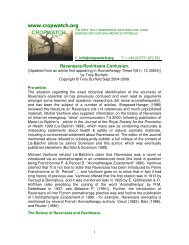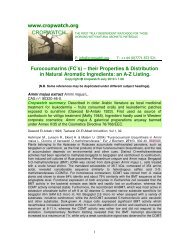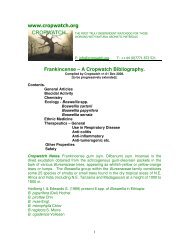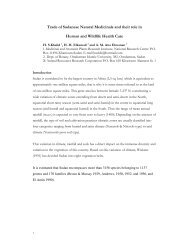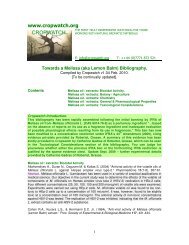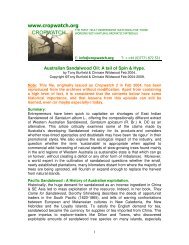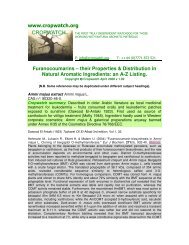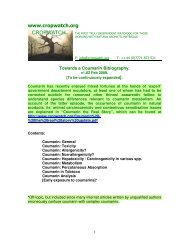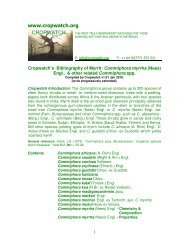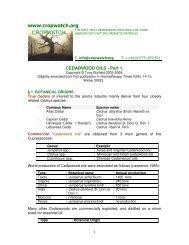Sandalwood Biblio - Cropwatch
Sandalwood Biblio - Cropwatch
Sandalwood Biblio - Cropwatch
You also want an ePaper? Increase the reach of your titles
YUMPU automatically turns print PDFs into web optimized ePapers that Google loves.
Jain S.H. Angadi V.G., Shankaranarayana K.H. & Ravikumar G. (2003) "Relationship between<br />
girth and percentage of oil in trees of sandal (Santalum album L.) provenances." <strong>Sandalwood</strong><br />
Research Newsletter 18. Abstract. In three provenance areas of sandal viz. Bangalore, Thangli<br />
(Karnataka) and Maryoor (Kerala), studies have been made in respect of GBH and oil. It was<br />
observed that percentage of oil remains nearly constant at 4 % after 80 cm girth and that rise in<br />
oil percentage beyond 80 cm girth was found to be just marginal.<br />
Jain S.H., Angadi V.G., Ravikumar G., Thegrajan K.S. & Shankaranarayana (1999) “Studies on<br />
cultivation & chemical utilisation of sandal (Santalum album L.).” PAFAI Journal 1, 49-53.<br />
Jain S.H., Angadi V.G., Rajeevalochan A.N., Shankaranarayana K.H., Theagarajan K.S. &<br />
Rangaswamy C.R. (1998) "Identification of provenances of Sandal in India for genetic<br />
conservation" ACIAR Proceedings, No.84, 1998, 117-120.<br />
Jain S.H. Augundi V.G. Rajeevalochan K.H., Shankaranarayana K.H., Theagarajan K.S. &<br />
Rangaswamy C.R (1992) “Identification of provenances of sandal in India for genetic<br />
conservation.” In: Sandal & Its Products ACIAR Proceedings 84, 117-120. .<br />
Jain S.H. & Rangaswamy C.R. (1998). "Soil properties and their relationship to the growth of<br />
Sandal (Santalum album L) in three study areas in Karnataka." My Forest 24, 141-146.<br />
Jirovetz L, Buchbauer G, & Jager W. (1992) “Analysis of fragrance compounds in blood samples<br />
of mice by gas chromatography, mass spectrometry, GC/FTIR and GC/AES after inhalation of<br />
sandalwood oil.” Biomed. Chromatography 6, 133-134. Abstract. After inhalation experiments with<br />
sandalwood oil and the pure fragrance compounds coumarin and alpha-terpineol, substances<br />
were detected and measured in the blood samples of test animals (mice) using gas<br />
chromatography/mass spectrometry (GC/MS) (MID) in connection with GC/FTIR (SWC), GC/AES<br />
(carbon and oxygen trace) and flame ionization detection/gas chromatography. Using tiglinic acid<br />
benzyl ester as the internal standard the following concentrations in serum could be found: alphasantalol<br />
6.1 ng/mL, beta-santalol 5.3 ng/mL and alpha-santalene 0.5 ng/mL. In separate<br />
inhalation experiments with coumarin and with alpha-terpineol the corresponding concentrations<br />
were 7.7 ng/mL and 6.9 ng/mL, respectively.<br />
Jones C.G., Ghisalberti E.L., Plummer J.A. & Barbour E.L. (2006) "Quantitative co-occurrence of<br />
sesquiterpenes; a tool for elucidating their biosynthesis in Indian sandalwood, Santalum album."<br />
Phytochemistry. 67(22), 2463-8. Abstract. A chemotaxonomic approach was used to investigate<br />
biosynthetic relationships between heartwood sesquiterpenes in Indian sandalwood, Santalum<br />
album L. Strong, linear relationships exist between four structural classes of sesquiterpenes;<br />
alpha- and beta-santalenes and bergamotene; gamma- and beta-curcumene; beta-bisabolene<br />
and alpha-bisabolol and four unidentified sesquiterpenes. All samples within the heartwood<br />
yielded the same co-occurrence patterns, however wood from young trees tended to be more<br />
variable. It is proposed that the biosynthesis of each structural class of sesquiterpene in<br />
sandalwood oil is linked through common carbocation intermediates. Lack of co-occurrence<br />
between each structural class suggests that four separate cyclase enzymes may be operative.<br />
The biosynthesis of sandalwood oil sesquiterpenes is discussed with respect to these cooccurrence<br />
patterns. Extractable oil yield was correlated to heartwood content of each wood core<br />
and the oil composition did not vary significantly throughout the tree.<br />
Jones C.G., Keeling C.I., Ghisalberti E.L., Barbour E.L., Plummer J.A., Bohlmann J.(2008)<br />
"Isolation of cDNAs and functional characterisation of two multi-product terpene synthase<br />
enzymes from sandalwood, Santalum album L." Arch Biochem Biophys. 2008 May 27. Abstract.<br />
<strong>Sandalwood</strong>, Santalum album (Santalaceae) is a small hemi-parasitic tropical tree of great<br />
economic value. <strong>Sandalwood</strong> timber contains resins and essential oils, particularly the santalols,<br />
santalenes and dozens of other minor sesquiterpenoids. These sesquiterpenoids provide the<br />
unique sandalwood fragrance. The research described in this paper set out to identify genes<br />
involved in essential oil biosynthesis, particularly terpene synthases (TPS) in S. album, with the<br />
long-term aim of better understanding heartwood oil production. Degenerate TPS primers<br />
48





